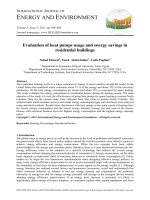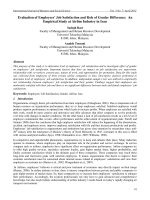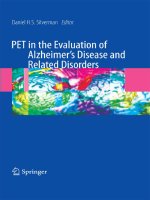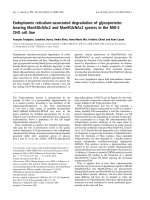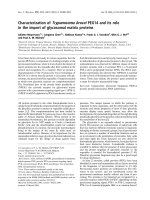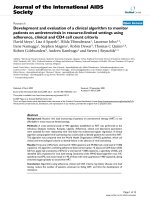Evaluation of the effect of GnRH analogue, progesterone and tolfenamic acid on serum progesterone profile and conception rate in repeat breeding crossbred cattle
Bạn đang xem bản rút gọn của tài liệu. Xem và tải ngay bản đầy đủ của tài liệu tại đây (229.42 KB, 8 trang )
Int.J.Curr.Microbiol.App.Sci (2020) 9(5): 2630-2637
International Journal of Current Microbiology and Applied Sciences
ISSN: 2319-7706 Volume 9 Number 5 (2020)
Journal homepage:
Original Research Article
/>
Evaluation of the Effect of GnRH Analogue, Progesterone and
Tolfenamic Acid on Serum Progesterone Profile and Conception
Rate in Repeat Breeding Crossbred Cattle
Sudhanshu Pratap Singh1*, Ankesh Kumar2, Prakrutik Prafulchandra Bhavsar3,
Mukesh Sahu4, Praveen Kumar1 and Sushil Kumar5
1
Department of Veterinary Gynaecology and Obstetrics, 2Department of Veterinary Clinical
Complex, 5Department of Veterinary Medicine, Bihar Animal Sciences University,
Patna, Bihar, India
3
College of Veterinary Science and Animal Husbandry, Anand Agricultural University,
Anand, Gujarat, India
4
Department of Veterinary Gynaecology and Obstetrics, College of Veterinary Animal
Sciences, G. B. Pant University of Agriculture and Technology, Pant Nagar, Uttarakhand,
India
*Corresponding author
ABSTRACT
Keywords
Repeat breeders,
Progesterone,
Tolfenamic acid,
Conception rate
Article Info
Accepted:
23 April 2020
Available Online:
10 May 2020
Secretion of prostaglandin F2α at the time of maternal recognition of pregnancy leads to embryonic loss.
Early embryonic losses are one of the important causes of repeat breeding which increases the calving
interval and leads to economic losses to farmers. Non-steroidal anti-inflammatory drugs inhibit the
synthesis of PGF2α. The present study was designed to study the effect of treatment by GnRH analogue Buserelin acetate, Progesterone (P4) and Tolfenamic acid on 32 repeat-breeding crossbred cattle aged 3-8
years. All the animals were randomly divided into 4 equal groups (n=8). Group 1 was taken as positive
control i.e. inseminated on spontaneous estrous without any therapy. Group 2 animals were treated with
injection Buserelin acetate @ 20 µg intramuscular (IM) at the time of artificial insemination (AI). Group 3
animals were treated with inj. Buserelin acetate @ 20 µg intramuscular at the time of AI followed by
Injection P4 @100mg IM on days 4, 5, 6 after AI. Group 4 animals were treated with inj. Buserelin acetate
@ 20 µg IM at the time of AI, inj. P4 @ 100mg IM on days 4, 5, 6 and inj. Tolfenamic acid @4 mg/kg
body weight IM on days 16, 17, 18 after AI. Blood samples were collected from all the cows at day 0, 7,
16, 17, 18 of the estrous cycle for the study of serum progesterone profile. The conception rate observed in
groups 1, 2, 3 and 4 were 12.5%, 37.5%, 50% and 75% respectively. Highest conception was observed in
group 4 in which, combinations of Buserelin acetate, Exogenous P 4 and Tolfenamic acid was administered.
The study concluded that combination of Buserelin acetate, Exogenous P 4 and Tolfenamic acid therapy
helps to maintain the P4 level and significantly increases the conception rate by 6 times than control group.
Introduction
The bovine conceptus produces interferon-tau
(IFNτ) which prevents luteolysis. In addition
to that functional corpus luteum (CL)
produces more progesterone which is
essential to supports pregnancy (Spencer and
Bazer, 2002). There are two crucial periods of
bovine pregnancy. The first period is the first
week of after breeding and second is day 8 to
2630
Int.J.Curr.Microbiol.App.Sci (2020) 9(5): 2630-2637
28, when maternal recognition of pregnancy
(MRP) takes place. Approximately 32% of
total embryonic loss occurs in this period
(Wiltbank et al., 2016). This leads to a repeat
of oestrous. Repeat breeding (RB) is a
considerable problem in cattle breeding which
leads to large economic losses due to more
inseminations, increased calving interval and
increased culling rates. Repeat breeding has
been defined as the failure to conceive from 3
or more regularly spaced services in the
absence of detectable abnormalities (Bartlett
et al., 1986).
Several factors like nutritional stress (Bender
et al., 2014), heat stress (Sakatani, 2017),
transportation stress (Merrill et al., 2007) or
other
stress
promotes
secretion
of
prostaglandin
F2α from the
uterine
endometrium. This can cause lysis of the
functional corpus luteum and leads to early
embryonic death (Hockett et al., 2004). The
two cyclooxygenase (COX) enzymes convert
arachidonic acid into prostaglandin-H2 which
is further converted into PGF2α through the
enzyme
prostaglandin-F-synthase.
The
NSAIDs exhibits anti-inflammatory activity
mainly based on the inhibition of the cyclooxygenase (COX) enzyme, results in
inhibition of prostaglandin synthesis (Malm
and Borisch, 2015).
Several studies evaluated the effects of
NSAIDs
like
Flunixine
meglumine
(Kasimanickam et al., 2019, 2018) and
meloxicam (Amiridis et al., 2009; McDougall
et al., 2016). Administration of the NSAID
tolfenamic acid has significantly improved
embryo transfer rate and pup delivery in mice
(Schlapp et al., 2015).
Administration of GnRH or GnRH analogue
before
artificial
insemination
induce
preovulatory LH (luteinizing hormone) surge
which
controls
ovulation,
or
post
inseminations with supplementation of
exogenous P4 to support early embryonic
development (Amiridis et al., 2009). At days
3 to 5 post-ovulation, the embryos usually
enter the uterus, undergoing genomic
activation and increases in P4 concentration;
therefore, this may be a physiologically
important time in the cattle, so the
administration of a low dose of P4 on days 4,
5 and 6 of the oestrous cycle increase the
conception rate among repeat breeder cattle
(Ferguson et al., 2012).
This extends the life span of the bovine
corpus luteum (CL) so this is one of the
strategies aimed at reducing embryo loss by
inhibiting the PGF2α in the endometrium
during the critical period (Binelli et al., 2001;
Pugliesi et al., 2011), Inhibition of PGF2α
enhances the CL lifespan and avoiding
detrimental and toxic effects of PGF2α on the
embryo (Binelli et al., 2001).
Materials and Methods
Preparation
of
animals
commencement of treatment
before
The study was conducted on 32 apparently
healthy, 3-8 years old repeat breeding
crossbred cattle. All animals were dewormed
with Fenbendazole @ 7.5 mg per kg body
weight 60 days prior to the commencement of
experiment and they were supplemented with
40 gm mineral mixture daily prior to
experiment.
Grouping of animals and treatment
Selected animals were randomly divided into
four groups (each group containing 8
animals). In group 1, animals were
inseminated on spontaneous estrous without
any treatment, in group 2, animals were
treated with injection Buserelin acetate @ 20
µg IM at the time of artificial insemination
(AI), in group 3, animal were treated with
2631
Int.J.Curr.Microbiol.App.Sci (2020) 9(5): 2630-2637
injection Buserelin acetate @ 20 µg IM at the
time of AI followed by Injection P4 @100mg
IM on days 4,5,6 after AI and in group 4,
animals were treated with injection Buserelin
acetate @ 20 µg IM at the time of AI,
Injection P4 @100mg IM on days 4,5,6 and
Inj. Tolfenamic acid @4 mg/kg body weight
IM On days 16,17,18 after AI. All the animals
were inseminated on spontaneous heat (Table
1).
Statistical analysis of the effect of different
treatments between the groups and within the
group on different days and serum P4
concentration in of repeat breeder cows was
studied by repeated measures ANOVA. The
multiple comparisons between group, day and
interaction for different parameters were done
by using Tukey test at 5% level of
significance. The analysis was done using
JMP 9.0 software.
Blood collection and hormonal assay
Results and Discussion
Assuming estrous day as day 0, blood
samples was collected in clot activator from
all the cows at day 0, 7,16,17,18 of the cycle
to harvest for hormonal estimation (Table 1).
Level of P4 in blood was estimated by RadioImmuno Assay (RIA) Progesterone essay kit
(M/S Beckman Coulter, Brea, CA) catalogue
no. IM 1188 as per the suggested protocol. In
brief all reagents were brought to the room
temperature (20-25°C) before assaying.
Conception rate
For estimation of serum progesterone, 50µl
standard and 50µl serum sample were taken
into antibody coated tubes.
500µl 125Ilabelled serum progesterone was added to
each antibody-coated tube.
Two additional non-coated tubes were
prepared for total activity computation
containing 500µl tracer (125I-labelled serum
progesterone) and was set-aside until
counting. The contents of the tubes were
mixed with a vortex and incubated for 1 hr for
serum progesterone estimation at room
temperature, while continuously shaking
(300-350 rpm).
The incubation mixture was carefully
aspirated while aspirator tip touched the
bottom of the antibody coated tube so that all
the liquid was removed. The radioactivity was
measured with SR-300 fully automatic
gamma counter.
The conception rates observed in the present
work in all four groups were 12.5%, 37.5%,
50% and 75% respectively in group 1, group
2, group 3 and group 4. The highest
conception rate was observed in group 4.
In a similar study by Amiridis et al., (2009)
reported highest conception rate of 33.76 % in
repeat breeder cows which is lower
conception rate than the present study.
(Aguiar et al., 2013) they reported conception
rate of 66.70% with the use of meloxicam- a
NASID and this is comparable with the
present finding while they obtained 49%
Conception rate in the control group which is
higher than the present report. Archbald et al.,
(1993) used GnRH at the time artificial
insemination and reported the conception rate
ranging from 33% - 40% this is comparable to
the present finding (Fig. 2).
While using progesterone in a low dosage by
(Ferguson et al., 2012) in an experiment
observed conception rate of 45% which slight
lower than the present finding.
Highest conception rate in present study was
observed in group 4 i.e. 75%, where treatment
had been given with combinations of GnRH
analogue (Busereline acetate), Exogenous
progesterone
and
non-steroidal
anti-
2632
Int.J.Curr.Microbiol.App.Sci (2020) 9(5): 2630-2637
inflammatory drug (Tolfenamic acid). All the
treatments were given at different days of
estrus cycle when the chances of conception
failure are more i.e. Buserelin acetate on day
0 when time of ovulation depend on
concentration of LH which is govern by
release of GnRH, then Progesterone injected
on day 4, 5 and 6 when embryo travels from
horn to uterus and Tolfenamic acid was given
on day 16, 17 and 18 when MRP process are
going on.
Least conception rate observed in group 1 in
which no treatment was given and kept as a
control. The combined administration of
GnRH, Progesterone, and NSAID was
effective in treatment of the repeat breeder
cows.
Serum progesterone profile
In group 1
The mean total P4 concentration on day 0, 7,
16, 17 and 18 was 0.31±0.06, 2.31±0.27,
3.99±0.23, 4.63±0.29 and 4.40±0.31 ng/ml,
respectively. The significant (p<0.05)
differences were observed between days,
significantly higher level were observed on
days 16,17 and 18 compared to days 0 and 7.
In group 2
The mean total P4 concentration on day 0, 7,
16, 17 and 18 was 0.37±0.06, 2.47±0.27,
5.06±0.47, 6.37±0.40 and 7.08±0.52 ng/ml,
respectively. The significant differences were
observed between days, significantly (p<0.05)
higher level were observed on days 17 and 18
compared to days 16, 7 and 0. The nonsignificant difference was observed among
days 16, 17 and 18 (Fig. 1).
In group 3
The mean total P4 concentration on day 0, 7,
16, 17 and 18 was 0.42±0.05, 2.81±0.23,
4.67±0.46, 5.69±0.49 and 6.44±0.58 ng/ml,
respectively. The significant differences were
observed between days, significantly (p<0.05)
higher level were observed similarly as in
previous group on days 17 and 18 compared
to days 16, 7 and 0.
In group 4
The mean total P4 concentration on day 0, 7,
16, 17 and 18 was 0.44±0.06, 2.71±0.22,
5.14±0.48, 7.13±0.46 and 8.41±0.54 ng/ml,
respectively. The significant differences were
observed between days, significantly higher
level were observed similarly as in previous
group on days 17 and 18 compared to days
16, 7 and 0 (Table 2).
The significantly (p<0.05) highest level of
progesterone was observed on day 18 in
group 4 and group 2 among all the treatment
groups and levels were 8.41±0.54 and
7.08±0.52 ng/ml respectively. The rising
trend of serum progesterone was observed in
all the treatment groups on days 0, 7, 16, 17
and 18 and significant differences (p<0.05)
was observed on days 17 and 18 between
groups.
On the day 17 and 18 of group 4, on the
administration of tolfenamic acid the mean
serum progesterone concentration was
7.13±0.46 and 8.41±0.54 ng/ml respectively
which was significantly higher between the
treatments which might have luteotropic
effect on corpus luteum, leading to increase in
serum progesterone concentration.
The similar observations were reported by
(Jaroszewski et al., 2009; Maithani, 2017; von
Krueger and Heuwieser, 2010). The reason of
this highest serum progesterone levels in
group 4 of the present experiment was the
combine administrations of GnRH analogue,
Progesterone and Tolfenamic acid.
2633
Int.J.Curr.Microbiol.App.Sci (2020) 9(5): 2630-2637
Table.1 Dose and dosage schedule of drugs in different treatment group
Cattle groups
(N= 8 in each group)
Treatment
Day of treatment
Day and time of
blood collection
Group-1 (Control)
No treatment
No treatment
At days 0, 7, 16, 17,
18 of estrous cycle
Group- 2
Inj.Buserelin Acetate @ 20 At the time of AI
µg IM
Inj.Buserelin
20µg IM
Acetate
At days 0, 7, 16, 17,
18 of estrous cycle
@ At the time of AI
At days 0, 7, 16, 17,
Inj.Progesterone@100mg
On days 4,5,6 after 18 of estrous cycle
IM
AI
Inj.Buserelin acetate @ 20 At the time of AI
µg IM
At days 0, 7, 16, 17,
Inj.Progesterone@100mg
On days 4,5,6 after 18 of estrous cycle
IM
AI
Inj.Tolfenamic acid @4 On days 16,17,18
mg/kg b. wt. IM
after AI
Group -3
Group -4
Table.2 Mean (± SE) serum P4 concentration (ng/dl) in different groups on 0, 7th, 16th, 17th and
18th day of estrous cycle in repeat breeder cows
Group
1
2
3
4
Day 0
Day 7
Day 16
Day 17
Day 18
0.31±0.06I
0.37±0.06I
0.42±0.05I
0.44±0.06I
2.31±0.27H
2.47±0.27H
2.81±0.23GH
2.71±0.22GH
3.99±0.23FG
5.06±0.47DEF
4.67±0.46EF
5.14±0.48CDEF
4.63±0.29EF
6.37±0.40BCD
5.69±0.49CDE
7.13±0.46AB
4.40±0.31EF
7.08±0.52AB
6.44±0.58BC
8.41±0.54 A
The values bearing the different superscripts across the rows and columns differ significantly
from each other, (P<0.05)
Table.3 Conception rate in different group of repeat breeder cows after treatment
Particulars
GROUP-1
GROUP-2
GROUP-3
GROUP-4
Total no. of animal
8
8
8
8
Pregnant animal
1
3
4
6
Conception rate
12.5%
37.5%
50%
75%
2634
Int.J.Curr.Microbiol.App.Sci (2020) 9(5): 2630-2637
Figure.1 Mean serum P4 concentration (ng/dl) in different groups on
0, 7th, 16th, 17th and 18th day of estrous cycle in repeat breeder cows
Figure.2 Conception rate in different group of repeat breeder cows after treatment
The increasing of serum progesterone was
observed
in
all
treatment
groups
simultaneously increasing in conception rate.
Since, higher concentration of progesterone in
early pregnancy directly related to embryonic
growth rate and pregnancy. The significant
increase in progesterone was observed in
group 4 where combined administrations of
Buserelin
acetate,
Progesterone
and
Tolfenamic acid were given. Hence, it is
concluded that combination therapies of
Buserelin
acetate,
Progesterone
and
Tolfenamic acid may be beneficial in the
treatment of repeat breeding problems.
References
Aguiar, T.S., Araújo, C. V., Tirloni, R.R.,
Martins, L.R., 2013. Effect of
meloxicam on pregnancy rate of
recipient heifers following transfer of in
vitro produced embryos. Reprod. in
Domes.
Anim.,
48,
984–988.
/>Amiridis, G.S., Tsiligianni, T., Dovolou, E.,
Rekkas, C., Vouzaras, D., Menegatos,
I., 2009. Combined administration of
gonadotropin-releasing
hormone,
progesterone, and meloxicam is an
effective treatment for the repeat-
2635
Int.J.Curr.Microbiol.App.Sci (2020) 9(5): 2630-2637
breeder cow. Theriogenology, 72(4),
542–548.
/>.2009.04.010
Barkhori-Mehni, S., Karami-Shabankareh, H.,
Masoumi, R., Kazemi-Bonchenari, M.,
Pezeshki, A., Badiei, A., Dirandeh, E.
and Colazo, M. G. (2018). Effect of
exogenous progesterone or flunixin
meglumine after AI on serum
progesterone
concentration
and
pregnancy per AI in lactating dairy
cows. Anim Reprod., 15(2):140–147.
/>Bartlett, P.C., Kirk, J.H., Mather, E.C., 1986.
Repeated insemination in Michigan
Holstein-Friesian cattle: Incidence,
descriptive epidemiology and estimated
economic impact. Theriogenology, 26,
309–322. />Bender, R.W., Hackbart, K.S., Dresch, A.R.,
Carvalho, P.D., Vieira, L.M., Crump,
P.M., Guenther, J.N., Fricke, P.M.,
Shaver, R.D., Combs, D.K., Wiltbank,
M.C., 2014. Effects of acute feed
restriction combined with targeted use
of increasing luteinizing hormone
content of follicle-stimulating hormone
preparations
on
ovarian
superstimulation, fertilization, and
embryo quality in lactating dairy cows.
J. Dairy Sci., 97(2), 764–778.
/>Binelli, M., Thatcher, W.W., Mattos, R.,
Baruselli, P.S., 2001. Antiluteolytic
strategies to improve fertility in cattle,
Theriogenology, 59(9), 1451–1463.
/>Ferguson, C.E., Kesler, D.J., Godke, R.A.,
2012. Improving pregnancy rates in
problem
breeder
cattle
by
administration of 15 mg of progesterone
on days 3-5 post-mating. J. App. Anim.
Res.,
40(3),
173–178.
/>645038
Hockett, M.E., Rohrbach, N.R., Schrick, F.N.,
2004.
Alterations
in
embryo
development
in
progestrogensupplemented
cows
administered
prostaglandin F2α. Prostaglandins.
Other Lipid Mediat., 73(3-4), 227–236.
/>2004.02.002
Jaroszewski, J.J., Markiewicz, W., Maślanka,
T.S., Skarzyński, D.J., 2009. Influence
of nonsteroidal anti-inflammatory drugs
on progesterone production by cultured
bovine luteal cells. Pol. J. Vet. Sci.,
12(3), 305–309.
Kasimanickam, R., Kasimanickam, V., Gold,
J., Moore, D., Kastelic, J.P., Pyrdek, D.,
Ratzburg, K., 2019. Injectable or
transdermal
flunixin
meglumine
improves pregnancy rates in embryo
transfer recipient beef cows without
altering
returns
to
estrus.
Theriogenology,
140,
8–17.
/>.2019.08.011
Kasimanickam, R.K., Hall, J.B., Estill, C.T.,
Kastelic, J.P., Joseph, C., Abdel Aziz,
R.L., Nak, D., 2018. Flunixin
meglumine improves pregnancy rate in
embryo recipient beef cows with an
excitable temperament. Theriogenology,
107,
70–77.
/>.2017.10.043
Koblischke, P., Budik, S., Müller, J. and
Aurich, C. (2010). Practical experience
with the treatment of recipient mares
with a non-steroidal anti-inflammatory
drug in an equine embryo transfer
programme. Reprod Domest Anim.
45(6):1039–1041.
/>Maithani, M., 2017. Studies on improving
2636
Int.J.Curr.Microbiol.App.Sci (2020) 9(5): 2630-2637
conception following embryo transfer in
cattle. G.B. Pant University of
Agriculture and Technology, Pantnagar
- 263145 (Uttarakhand).
Malm, H., Borisch, C., 2015. Analgesics,
non-steroidal anti-inflammatory drugs
(NSAIDs), muscle relaxants, and
antigout medications, in: Drugs During
Pregnancy and Lactation: Treatment
Options and Risk Assessment: Third
Edition.
pp.
27–58.
/>McDougall, S., Abbeloos, E., Piepers, S.,
Rao, A.S., Astiz, S., van Werven, T.,
Statham, J., Pérez-Villalobos, N., 2016.
Addition of meloxicam to the treatment
of clinical mastitis improves subsequent
reproductive performance. J. Dairy Sci.,
99(3),
2026–2042.
/>Merrill, M.L., Ansotegui, R.P., Burns, P.D.,
MacNeil, M.D., Geary, T.W., 2007.
Effects of flunixin meglumine and
transportation on establishment of
pregnancy in beef cows1. J. Anim. Sci.,
85(6),
1547–1554.
/>Pugliesi, G., Shrestha, H.K., Hannan, M.A.,
Carvalho, G.R., Beg, M.A., Ginther,
O.J., 2011. Effects of inhibition of
prostaglandin F 2α biosynthesis during
preluteolysis and luteolysis in heifers.
Theriogenology,
76(4),
640–651.
/>
.2011.03.017
Sakatani, M., 2017. Effects of heat stress on
bovine
preimplantation
embryos
produced in vitro. J. Reprod. Develop.,
63(3),
347–352.
/>Schlapp, G., Goyeneche, L., Fernández, G.,
Menchaca, A., Crispo, M., 2015.
Administration of the nonsteroidal antiinflammatory drug tolfenamic acid at
embryo transfer improves maintenance
of pregnancy and embryo survival in
recipient mice. J. Assist. Reprod Genet.,
32(2),
271–275.
/>Spencer, T. E., & Bazer, F. W. 2002. Biology
of progesterone action during pregnancy
recognition and maintenance of
pregnancy. Front. Biosci., 7(7), d1879d1898.
von Krueger, X., Heuwieser, W., 2010. Effect
of flunixin meglumine and carprofen on
pregnancy rates in dairy cattle. J. Dairy
Sci.,
93(11),
5140–5146.
/>Wiltbank, M.C., Baez, G.M., Garcia-Guerra,
A., Toledo, M.Z., Monteiro, P.L.J.,
Melo, L.F., Ochoa, J.C., Santos, J.E.P.,
Sartori, R., 2016. Pivotal periods for
pregnancy loss during the first trimester
of gestation in lactating dairy cows.
Theriogenology,
86(1),
239–253
/>.2016.04.037
How to cite this article:
Sudhanshu Pratap Singh, Ankesh Kumar, Prakrutik Prafulchandra Bhavsar, Mukesh Sahu,
Praveen Kumar and Sushil Kumar. 2020. Evaluation of the Effect of GnRH Analogue,
Progesterone and Tolfenamic Acid on Serum Progesterone Profile and Conception Rate in
Repeat Breeding Crossbred Cattle. Int.J.Curr.Microbiol.App.Sci. 9(05): 2630-2637.
doi: />
2637
